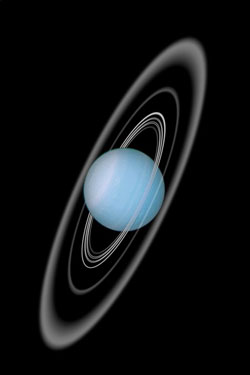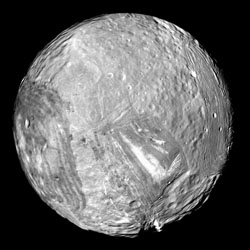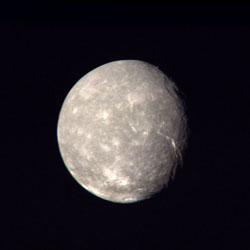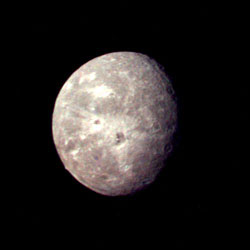Uranus - The Sideways Planet

Most of the planets in the Solar System orbit the Sun like a top spinning across the floor, with their spin-axes more or less vertical to their direction of motion. Not Uranus. It rolls along its orbital plane like a wheel. Something must have tipped Uranus on its side – possibly a collision.
Whatever the cause, the extreme tilt produces radical seasonal changes on Uranus. Seasons result when the amount of sunlight reaching a given part of a planet changes over the course of the year. Uranus’s tilt, plus the fact that its year lasts 84 Earth years, means that whole sections of the planet point at the Sun for 21 years at a time without experiencing darkness – a recipe for extreme seasons and weather.
Uranus Facts:
Average distance from Sun: 3 billion km
Orbital period: 84 Earth years
Rotation period: 17 hours
Diameter at equator: 4 x Earth’s
Mass: 15 x Earth’s
Tilt of axis: 98°
Number of moons: At least 27
Number of rings: At least 12
Meet the Moons
Most moons are named for figures in Greek and Roman mythology. But John Herschel, the son of the discoverer of Uranus, had a fondness for English literature. Therefore the moons of Uranus have names like Oberon, Titania, Ariel, and Miranda – from Shakespeare’s plays Midsummer Night’s Dream and The Tempest.
 Miranda
Miranda, a moon that appears to have broken apart and then reassembled.
 Ariel
Ariel, a bright moon with a young icy surface.
 Titania
Titania, Uranus' largest moon.
 Oberon
Oberon, with an icy surface scarred by ancient craters.
Our Sharpening Picture of Uranus
Uranus was the first planet discovered with a telescope. William Herschel, a musician and amateur astronomer, realized it was something other than a star in 1781. The view of Uranus did not improve much until 1986, when the Voyager 2 space probe flew by. Since Voyager, the Hubble Space Telescope and Keck Observatory in Hawaii have made detailed images of Uranus.
1781 – William Herschel, discoverer of Uranus, holding a drawing of the planet and two of its moons.
1915 – Drawing based on telescopic observations of Uranus.
1972 – A telescopic view of Uranus and five of its moons.
1986 – Voyager 2 becomes the first space probe to fly past Uranus.
2004 – Uranus imaged with the world’s largest optical telescope at the Keck Observatory in Hawaii.
2006 – The Hubble Space Telescope detects a dark cloud feature on Uranus (just right of the center of this image).
Reasons for the Seasons
The Greater a Planet’s Axial Tilt, the More Extreme its Seasons
A planet has seasons if its axis of rotation is tilted relative to its orbital plane. The tilt causes the amount of sunlight reaching the planet to vary from place to place. Earth’s axis is tilted by 23.5°, producing our familiar pattern of seasons. By contrast, Uranus is tilted by more than 90°, which produces very extreme seasons indeed.



